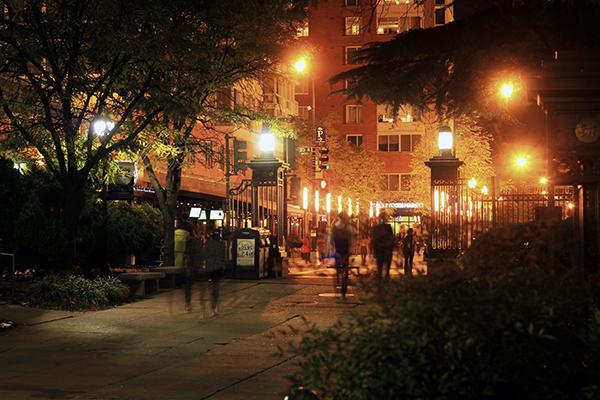Officials are planning to add extra security measures to a park near campus.
Local officials unanimously passed a resolution Wednesday night asking the University, the Washington Metropolitan Area Transit Authority and the GW Hospital to pay for additional lighting in a park outside the Foggy Bottom Metro station, commonly called the I Street Mall. A sexual assault and a sexual fondling were both reported in the area over the last year, and supporters of the resolution said they hope the better lighting will make the area more secure for those who pass through it.
The park includes trees, tables and benches between Ross Hall, the Foggy Bottom Metro station and the GW Hospital. It is a busy space that also intersects I Street and New Hampshire Avenue, where students frequently cross to enter campus or go to residences like City Hall and the Elise Apartments.
In a high-profile incident last winter, a GW student was raped by three men in an alleyway on New Hampshire Avenue between 24th and I streets, which is across the street from the park. Another student reported being sexually fondled at 24th and I streets earlier this month.
Eve Zhurbinskiy, a sophomore and commissioner on the Foggy Bottom and West End Advisory Neighborhood Commission, said that she proposed the resolution in response to the fondling case from earlier this month.
“Something needs to be done to improve safety in that plaza,” Zhurbinskiy said at the meeting. “I think increasing lighting is a good way to do so.”
Zhurbinskiy also cited the results of the campus climate survey GW released last January which found that 21 percent of the female freshmen who completed the questionnaire do not feel safe on campus at night.
University spokeswoman Maralee Csellar said in an email that the Foggy Bottom Campus has an “extensive” video surveillance system that allows officers in the University Police Department to monitor public areas on campus. She did not give details of the location of the cameras near the I Street Mall. There is one blue light, which students can use to call UPD in an emergency, located at the end of the mall by the Metro station.
“We are still reviewing the resolution and do not have any updates at this time,” Csellar said. “We continue to monitor and evaluate the activity across campus and make adjustments as needed to all of our security protocols.”
Susan Griffiths, a spokeswoman for the GW Hospital, declined to say whether hospital officials are considering the resolution to add more lighting to the I Street Mall, but said the hospital staff “recognizes the importance of safety in the Foggy Bottom community.”
“We view this area as a place of learning and healing and work with our community partners and the University to ensure it remains that way,” Griffiths said.
Zhurbinskiy said in an interview that the new lighting would not be a solution to the crime in the area, but would be a step in the right direction. She said she met with officials from the Office of Government and Community Relations two weeks ago to discuss the current security measures in the park.
“My question is: If they [UPD] are supposedly there at the plaza patrolling, why is all this crime still occurring?” Zhurbinskiy said.
Patrick Kennedy, the chairman of the ANC and an alumnus, said adding lights would make the area less “eerie,” but officials should also consider adding water features or removing shrubs to make better use of the space. He suggested using Square 80, located between by Guthridge and South halls, as a template for how an open area that can be made more useful to the community. Tables and benches line Square 80, and University-sponsored events take place there throughout the year.
“We have to understand what steps we can take in terms of design. People should never feel unsafe walking through this space,” Kennedy said.
He said students and faculty should be able to pitch their ideas for ways to improve the space.
“Having students bring this to light helps show the University that this is something we consider a priority,” Kennedy said. “The best thing we can do is continue to focus on this and bring the issue to light.”







